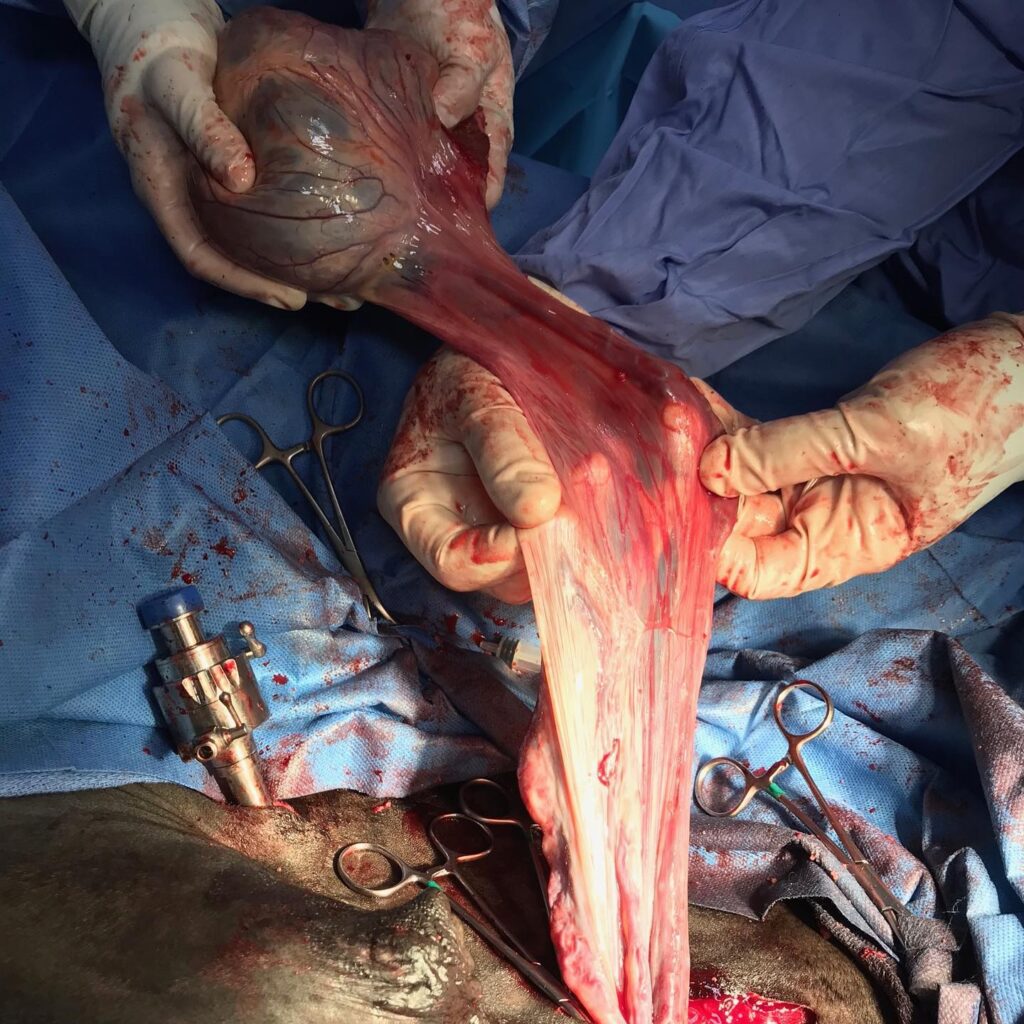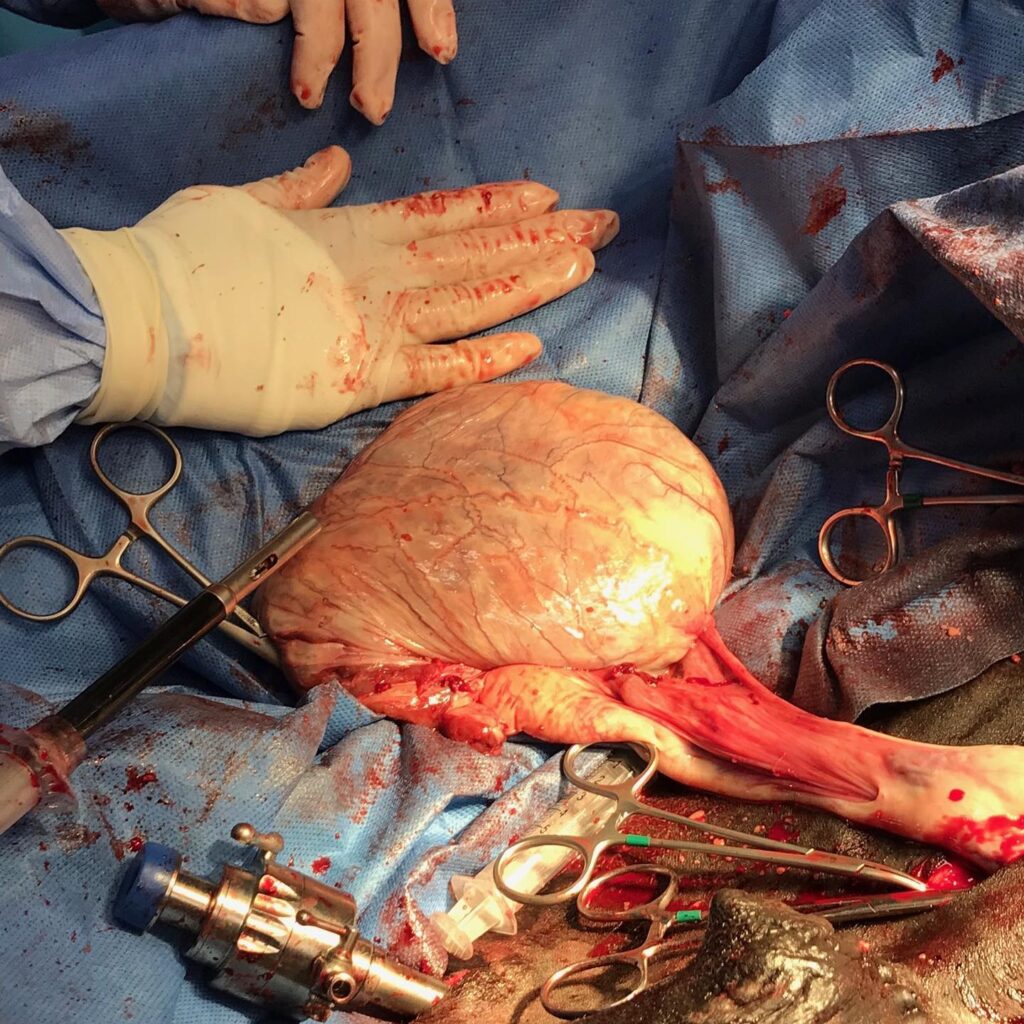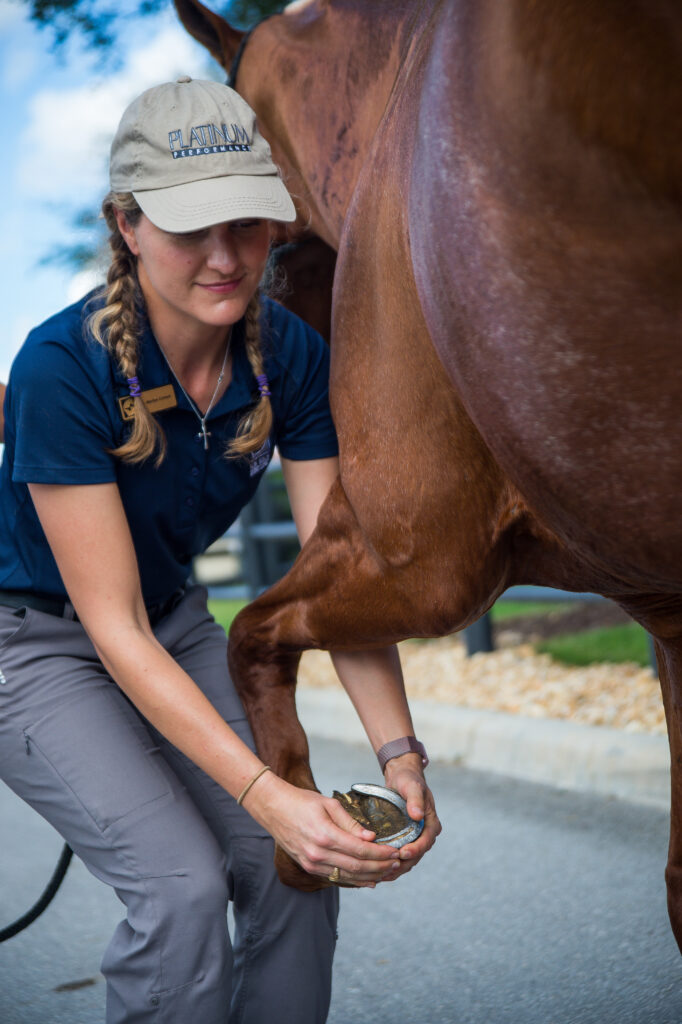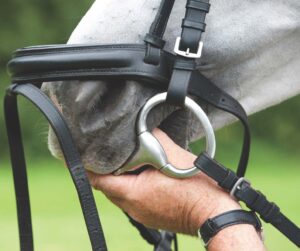Category: Medical
When Debbie Cruz imported her 2012 Friesian from Europe, she was excited to welcome the gelding into her life. However, the mount she purchased as a gelding from The Netherlands still had a lot of stallion left in him. Literally.
Marquis, Cruz’s hopeful dressage mount, arrived safe and sound to her home in Miami, FL, in early 2020. When he started to display quintessential stallion-like behavior, she called her veterinarian, Dr. Joseph Zerilli, to help her determine the cause of this very “un-gelding like” behavior.
“I was told that he had been gelded while in The Netherlands, but when he came home, he was acting exactly like a stud rather than the sweet gelding I thought would be arriving,” said Cruz. “I wasn’t sure what the cause could have been, but I knew something wasn’t right.”
Dr. Zerilli performed a blood test as part of his exam, which revealed very high levels of testosterone for a horse that was supposed to be a gelding. The level of testosterone present was a solid marker for a retained testis, one that would require surgery to remove. Marquis was referred to Dr. Weston Davis, a board-certified surgeon at Palm Beach Equine Clinic in Wellington, FL.
Dr. Davis used a hCG stimulation test and abdominal ultrasound to determine if testicular tissue was present and the source of Marquis’ testosterone levels were confirmed: he was a cryptorchid. Also known as a “rig” or “ridgling,” a cryptorchid horse has one or both testes that are not fully descended into the scrotum. In Marquis’ case, he had a retained left testis within the abdomen.
In a normal stallion, the testes gradually descended from just below the kidneys, through the inguinal canal, and into the scrotum. This happens either in utero or during the first few weeks of life. Occasionally, either one or both testes fail to descend for reasons that are still not fully understood by veterinarians. A cryptorchid stallion can be further classified as either inguinal when the testis is in the inguinal canal, or abdominal when the testis remains in the abdominal cavity, which was the case for Marquis.

“During surgery, the horse was placed under general anesthesia and we used the laparoscopic camera inserted into the abdomen to examine the retained testis,” said Dr. Davis.
A laparoscopy is an endoscopic procedure where a fiberoptic video camera and surgical instruments are introduced into the abdomen through a small incision. This permits the observation of the inside of the abdomen and allows abdominal surgeries to be performed without a large incision into the abdominal cavity.
“We could see that there was torsion, which indicates restricted blood flow and often pain, as well as severe enlargement,” said Dr. Davis. “The testis, which had become quite large, was then exteriorized through an enlarged paramedian incision. Marquis recovered from anesthesia without complication and with an excellent prognosis.”
“The biggest victory in this rather rare case is that the horse was relieved of pretty severe discomfort and the owner could enjoy the gelding disposition she was expecting.”
Dr. Davis
Aside from pain from the torsion and subsequent enlargement within the body, Marquis’ risk of developing malignant (cancerous) tumors was increased with the testis left inside his body. Prompt diagnosis and surgery likely prevented more critical problems in the future for Marquis.
After recovering from surgery at Palm Beach Equine Clinic’s onsite hospital, Marquis was returned home to Cruz without his retained testis and a new attitude.
“I am very grateful to have had my horse seen by Dr. Weston Davis and his staff. I am not only happy that he was able to get his surgery with one of the best surgeons in the country, but also that it was such a success.”
Debbie Cruz
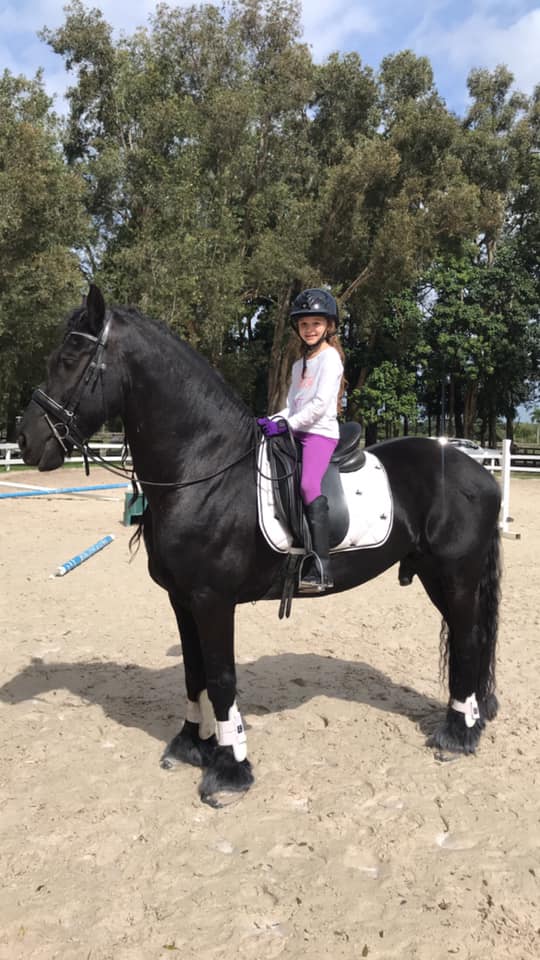
Marquis’ recovery progressed quickly after he returned to his home barn, and he is now back in the tack with Cruz. “I am looking forward to a long journey with him,” she said. “I am thankful to everyone at Palm Beach Equine Clinic for the care they provided Marquis. I couldn’t see myself going anywhere else.”

Anyone who has experience with horses is aware of the very real threat of losing a horse to colic or other gastrointestinal disease. But looking back on the history of equine death causes, colic still holds the same percentage as it did 20 years ago, standing firm as the second highest cause of death behind natural causes. Why hasn’t modern medicine decreased the chance of losing horses to colic? Why do we all still share the common fear of our horses colicking out of the blue, with little warning and minimal reliable strategies to prevent problems?
The answers to these questions remain a work-in-progress, but over the past 10 years, veterinarians and researchers have learned a lot about the role of the equine gut microbiome on all sorts of health outcomes, including colic, maldigestion, dysbiosis, and a myriad of other health problems.
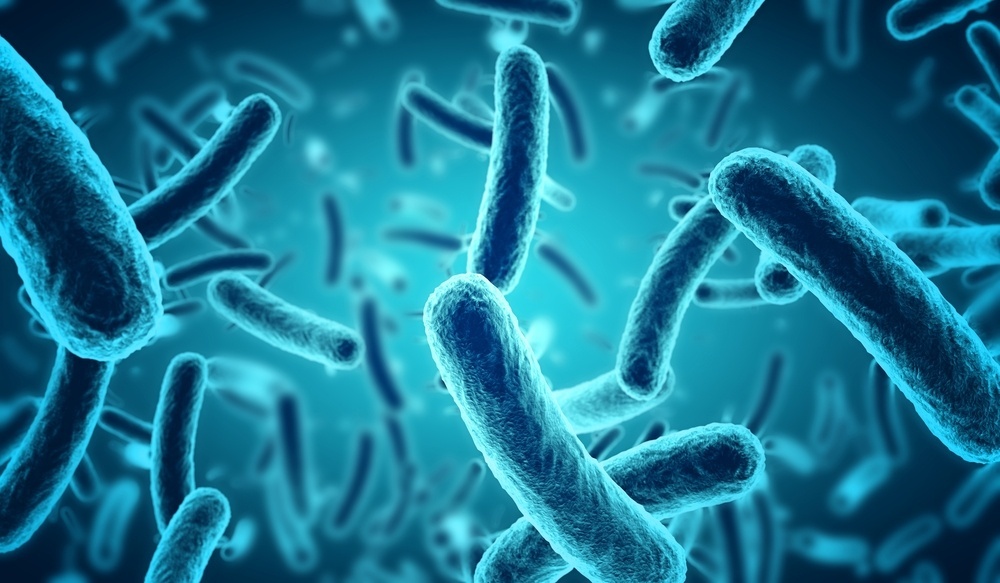
The equine gut microbiome is an ecosystem composed of quadrillions of microbes, including bacteria, fungi, and even viruses, which interact and coexist in the gastrointestinal tract and contribute to overall gut health and well-being. In equines, when the microbiome is disrupted in such a way that populations of beneficial bacteria and yeast have declined and/or populations of harmful pathogenic bacteria and yeast have increased, it is not unusual to see issues such as colic and colitis, laminitis, among other serious conditions.
Like each individual horse, each microbiome is unique; regional, dietary, and even breed and genetic differences can create diverse microbiomes, and varying degrees of digestive health. Even within one horse’s microbiome, the “top end” of the colon can be drastically different from the “bottom end” in terms of the population and diversity of microbes. The way all the organisms perform and act within the microbiome determines the functionality of the gut as a whole. Board-certified internal medicine specialist Dr. Peter Heidmann leads the Internal Medicine department at Palm Beach Equine Clinic and takes us on a deeper dive into the equine gut microbiome.
Microbiome and Nutrition
“When we’re working to improve overall GI health, we are basically trying to increase the population of ‘good bugs’ and crowd out the ‘bad bugs,” Dr. Heidmann remarked. The combination of probiotics, prebiotics, and diet are all key factors that influence what happens on the inside of a horse’s gut. According to Dr. Heidmann, a well-balanced diet is most important, but the sources of nutrients also play a huge role in promoting gastrointestinal health.
“Probiotics can limit lactic acid production and prevent huge swings in pH in the cecum. This happens through many pathways, but largely by encouraging fiber fermenters over bacteria that like to gobble sugars and produce lactic acid,” he said. “Prebiotics provide additional, non-starch nutrients and are meant to support healthy flora, or microbes. Prebiotics also limit the likelihood and severity of dysbiosis, or microbial imbalance, when the diet changes, like what can happen following sudden exposure to too much starch-rich feed.”
Excessive amounts of starch-rich grains can reduce populations of healthy flora, decrease the types of bacteria that are present in the colon, and also promote overgrowth of unhealthy flora. In turn, overly homogenous populations limit a horse’s resilience to stress, dietary changes, and other unpredictable changes such as those in weather.

Oats and other starch-rich grains cause increases in propionic acid-producing bacteria, while hay-only diets increase acetic acid-producing flora, and therefore promote more diverse and stable populations of beneficial bacteria and yeasts. On the flipside, feeding hay and no grain means the nutrients are being digested much more slowly and will promote more diversity and stability of flora populations.
“At the same time, some ‘good’ bugs are also decreased when a hay-only diet is fed, especially ones that rely on easy-to-digest starchy grains,” noted Dr. Heidmann. “One type of organism, the Lachnospiraceae, is among the most prevalent type present in a healthy horse’s hindgut, and its population also diminishes when grain is not being fed.”
Ultimately, some easily digestible concentrate feeds promote healthy bacterial populations and release lots of energy quickly, yet it is fairly easy and risky to over-do the easily digestible feed. Not only do abrupt changes in diet increase the risk of upsetting a horse’s healthy microbiome, but feeds that are high in carbohydrates can also promote gas formation, lactic acidosis, and other types of colic. “Simply put, garbage in equals garbage out,” Dr. Heidmann explained.
Other Stressors to the Microbiome
Aside from what goes into the horse, there are other factors that determine the behavior of the microbiome and the overall functionality of the gut. Genetic makeup almost certainly plays a role in the way organisms manage the nutrients going in and, in turn, impacts the horse. Stress is another significant factor that definitely has a relationship with the gut, though it remains difficult to draw clear lines of “cause and effect” when studying all the ways that stress affects a horse’s gut health.
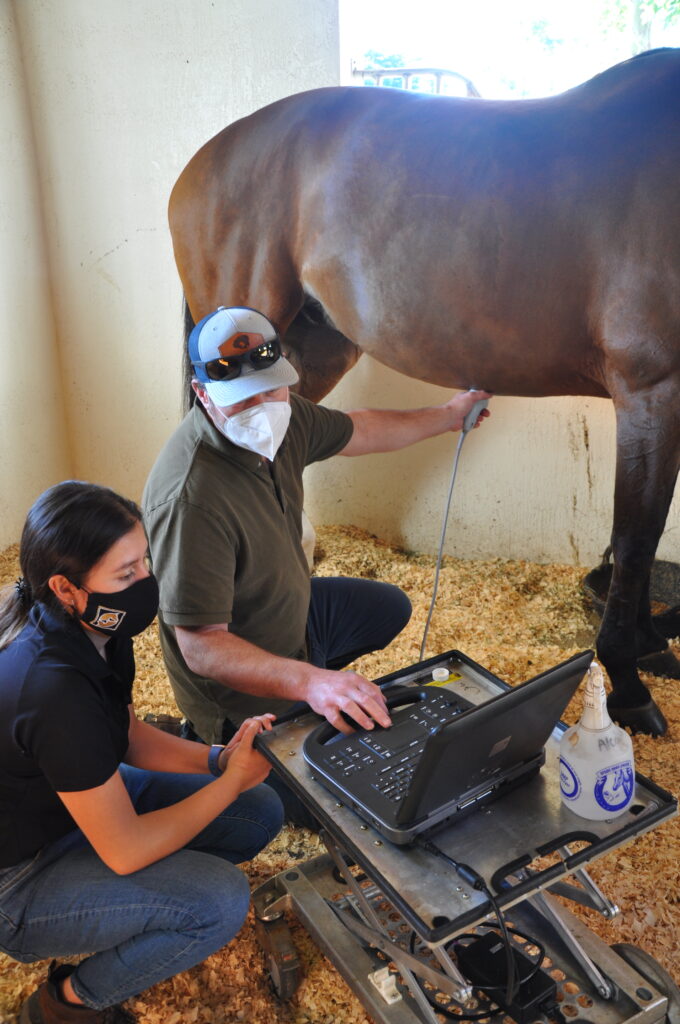

It is common knowledge among trainers that horses with anxious, “stressed-out” personalities seem prone to developing stomach ulcers. Separate from stress caused by riding, changes in surroundings, or even changing stablemates can make a difference in the organisms in a horse’s gut. Even when the feeding program remains consistent, a change in workload or their neighboring stall-mate invites stress and can promote ulcers.
“There is reason to believe that colon ulcers indicate problems in the gut microbiome,” said Dr. Heidmann. “Organisms, both healthy and not, vary between different barns, even in the same region or town, and those differences are also associated with differences in a horse’s microbiome. Even if horses are on the exact same food, with the same hay and turnout schedule, the flora is going to be different due to varying exposure to new microorganisms.” But this doesn’t mean we shouldn’t subject our horses to change. Many competition horses are accustomed to changes in environment and can perform without major gastrointestinal issues. The primary goal is to maintain as much consistency as possible when horses go through geographical changes that may disrupt their gut health.
“The relationship between stress and gut health isn’t as simple as a cause-and-effect relationship, where stress leads to a direct change in the behavior of the bugs, or where a change in flora directly increases a horse’s stress levels. It is a complex, dynamic interaction; it’s a constant feedback loop.”
Dr. Heidmann
It is difficult enough to separate cause from effect when looking at the relationships between gastrointestinal flora and factors like diet, exercise, pre- and probiotics, or supplemental digestive enzymes. But explaining the relationship between horse’s behavior and their GI flora is inherently subjective, and therefore even more difficult to confirm.
“It may seem far-fetched to think that a horse’s behavior might be affected by the balance of flora in their GI tract, but some microbes appear to have developed mechanisms that encourage certain behaviors by producing compounds that mimic the horse’s own neurotransmitters,” reflected Dr. Heidmann. “This can translate into increasing hunger signals or stimulating cravings for certain foods. Some microbes can enhance taste sensation, and others can co-opt a horse’s normal signaling pathways to enhance mood or increase discomfort by slowing gastrointestinal motility. Any or all of these mechanisms may be up or down regulated during changes in the balance of GI flora.”
Still More to Learn
Veterinary science and research still have a long way to go to draw firm associations between illness and the microbiome. According to Dr. Heidmann, “it’s not known yet if the disease is the cause of the change in microbiome flora or if it is the result of a change in the flora, but for sure there is a strong relationship between these things. For now, we don’t yet know if the horse has an unusual balance of organisms because of its problems with chronic colic, or if it is the reverse: that the colic is rooted in an unusual balance of GI organisms.”
With today’s modern scientific tools and research methods, we are closer than we’ve ever been to understanding the dynamics between microbiome and overall health. Comprehensive understanding of the interplay between diet and digestion, between the microbiome and behavior, and between food and flora remains a work-in-progress, but ongoing studies promise to shed light on our current understanding.
In the interim, a consistent regime of diet and exercise, with workload tailored to each horse’s skillset and stage of training, remain the best ways to minimize risk and promote healthy GI flora. “Prebiotics and probiotics and other micronutrients are sometimes necessary,” said Dr. Heidmann, “but the most important things remain hay and sunshine, water and exercise, and consistency most of all.”
Appointment Request
Please fill out this form and our staff will contact you to confirm an appointment.
Identifying the root of performance issues in equine athletes can be like connecting a puzzle of often-ambiguous signs, or a process of elimination through diagnostics. Veterinarians can exhaust all the tools in their medical arsenal trying to figure out why a horse may be losing muscle mass and stamina or refusing to work, but the answer could be hiding in the horse’s muscle tissue. Palm Beach Equine Clinic’s Internal Medicine Specialist Peter Heidmann, DVM, DACVIM, has a keen interest in connecting these signs and identifying muscle disorders.
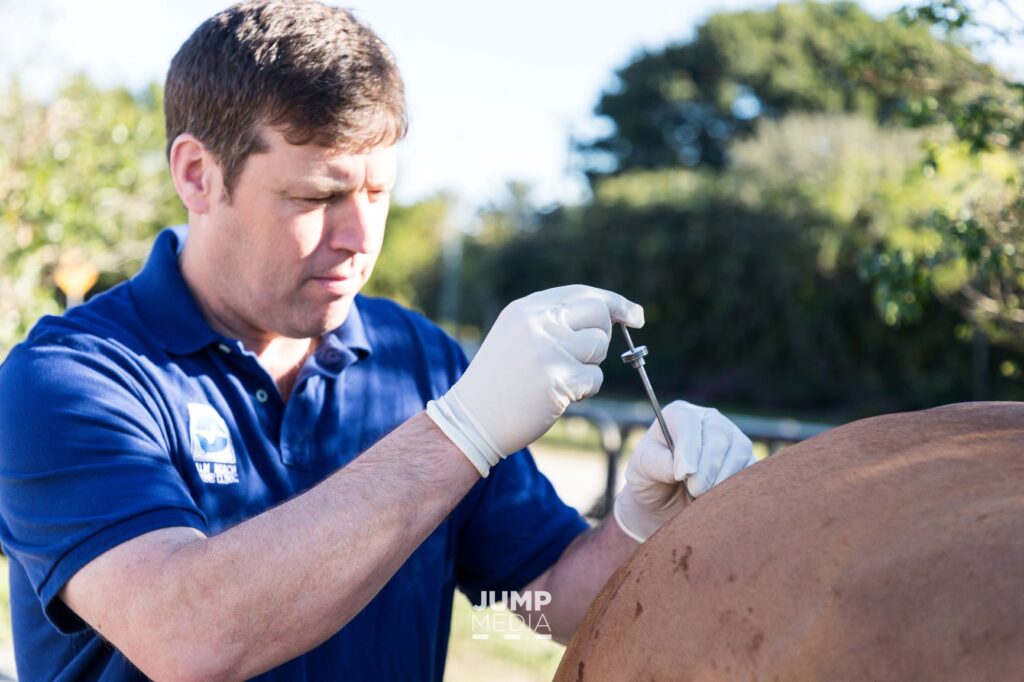
“Correctly diagnosing and treating muscle disorders in horses can be a very rewarding process, because once you develop an effective treatment plan, the horse will usually experience an extraordinary recovery. I’ve had cases where we sent muscle biopsy samples to a pathologist, enacted a treatment plan, and then sent another sample six months later to check our progress. The results were so impressive that the pathologist called to confirm that it was the same horse!”
Dr. Heidmann
Muscle disorders can present with a range of signs from muscle stiffness and pain to extreme cases of muscle atrophy. Most commonly, presentations occur during training and may include pain, stiffness, tremors, and a reluctance to move. Such symptoms usually lead veterinarians to conduct a full lameness evaluation.
“We usually look at mechanics first, and when there is no lameness determined and no joint, tendon, or ligament issues, we can further narrow down the search to determine if there is nerve impingement leading to muscle atrophy,” said Dr. Heidmann, who will often see a horse with such impingement work very well at an extended trot, but lose all power or appear stiff and lame as soon as the gait is collected.
To confirm a horse’s neuromuscular health and proper function, Dr. Heidmann will first run a blood panel to test for abnormal elevations in two enzymes. The first is serum creatine kinase (CK), which is released within just a few hours of muscle damage. Elevations in CK are usually consistent with training, transport, or taxing exercise. The second is serum aspartate transaminase (AST), which is an enzyme that rises more slowly after muscle injury, and can provide a veterinarian with knowledge about the body’s longer-term response.

“If you think of muscle cells as little balloons, once you pop one, CK and AST are released into the blood,” said Dr. Heidmann. “When these numbers are high, we know we have way too many balloons popping all at the same time. Then we just have to figure out why.”
Neuromuscular Biopsies Leading to Diagnoses
The diagnosis of a particular neuromuscular disorder can be challenging, since many of the symptoms are the same, regardless of the underlying disease. After blood testing, neuromuscular disorders can be diagnosed using a muscle biopsy. This minimally invasive, but highly revealing procedure is one that Dr. Heidmann turns to often in order to not only diagnose, but to also provide life and career-saving treatments.


“I usually use a Bergstrom needle, which is used to collect the sample through a tiny site in the horse’s skin. The muscle tissue then falls into a slot in the needle, and is removed to be examined under a microscope,” said Dr. Heidmann, who also says the most common locations for collecting muscle biopsies, depending on the symptoms, include the triceps, top line, hamstring, gluteal muscle, and tail head of a horse. “You can physically see some of the things that aren’t functioning properly even if the enzymes aren’t high.
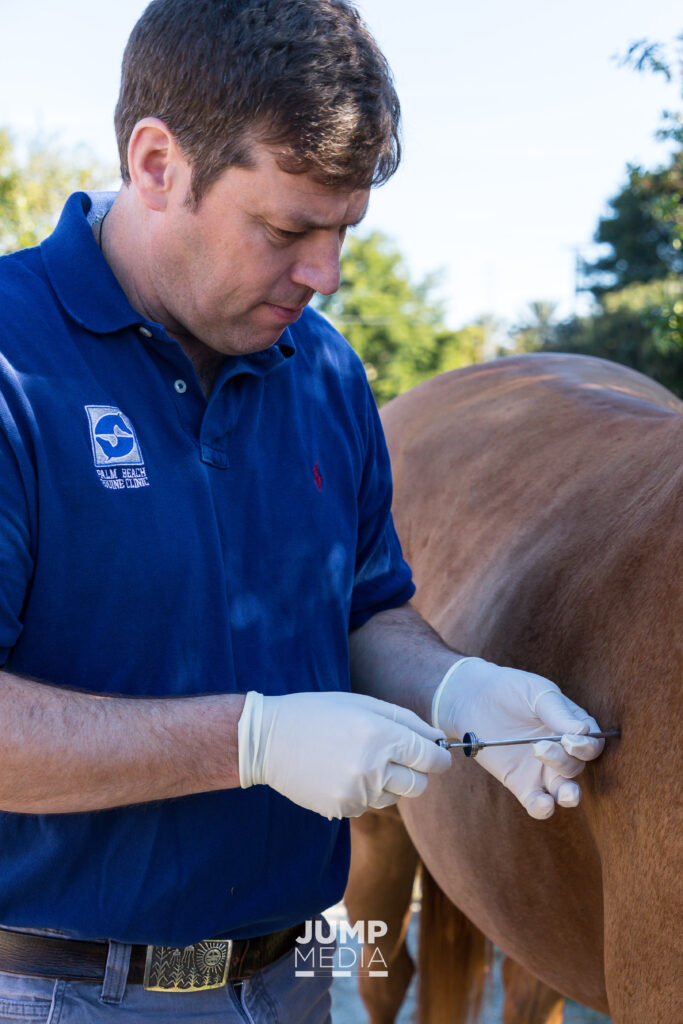
“The beauty of a muscle biopsy is that you are looking at where the nerves come into the muscle, so you can detect abnormal nerve supply to an area while leaving the horse with nothing more than a nick in the skin,” he continued. “Once we see the muscle tissue, we can tell if the horse requires nutritional changes, injections, or other treatments. Non-invasive nerve stimulation is what the future holds for the treatment of many muscle disorders, but it is still an evolving treatment in veterinary medicine right now.”
Once the muscle biopsy is collected, Dr. Heidmann can go to work identifying the problem while the horse immediately returns to work. Non-invasive diagnostics and treatments are the wave of the future in both human and equine medicine. For Dr. Heidmann, neuromuscular biopsies are helping him to look below the surface of a horse’s skin to evaluate, diagnose, and provide treatments without making a single cut.
Learn more about Equine Internal Medicine by clicking here.
Appointment Request
Please fill out this form and our staff will contact you to confirm an appointment.
Catch up on Part 1 of Considerations for the Aging Performance Horse first by clicking here.
Provide a safe, comfortable environment
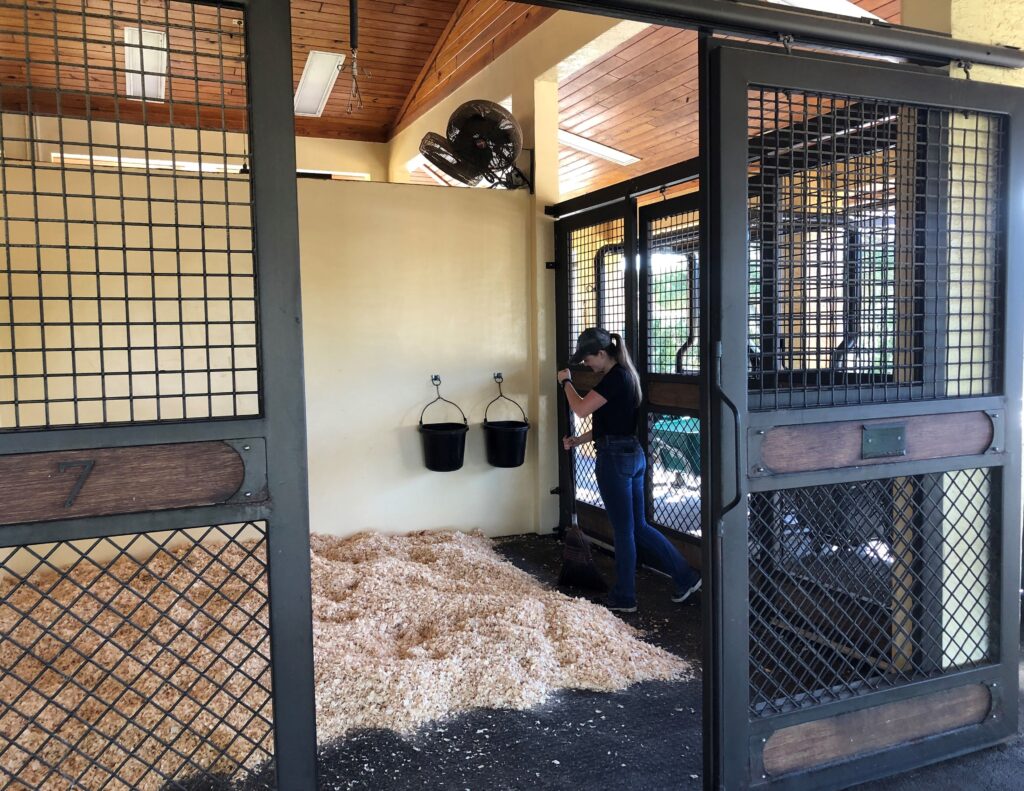
Ensuring your aging has a well-bedded, sanitary space with adequate water and protection from rain, snow, direct sun, and biting insects will help keep them comfortable. Middle-age and senior horses may also become more sensitive to respiratory irritants such as mold, fungus, dust, and pollen. As a result, it is recommended that barn and stall cleaning is done while the horse is in turnout or being ridden so they do not breathe in dust stirred up during cleaning. Minimizing their exposure to these irritants by maintaining a clean and well-ventilated stable will go a long way in keeping an older horse healthy.
Schedule regular veterinary performance evaluations
Like all athletes, horses can experience physical setbacks and are not always so quick to bounce back as they age. Osteoarthritis and laminitis are two common medical conditions that become more prevalent with age. It is important for the middle-age and senior performance horse to be managed with proper veterinary care, farriery, and a suitable training program.
Routine performance evaluations by a veterinarian are a useful tool in detecting subtle changes in a horse’s gait and movement before issues become injuries. A veterinarian will be able to suggest the appropriate treatment, such as anti-inflammatories, joint injections, biologic therapies, or alternative medicines, to maintain and even increase the horse’s flexibility, range of motion, balance, and ease any discomfort. Many owners begin consulting their veterinarian on regenerative and alternative therapies well before their horse has reached senior years as these therapies may help to support longevity in performance and better health for the horse’s organ and musculoskeletal systems.
Pay attention to changes in behavior and contact your veterinarian
Changes in the horse’s behavior or energy level, even minor or seemingly unimportant changes, can be indicators of underlying issues or disease. Exercise intolerance, poor coat condition, weight loss, stiffness, dropping feed, or changes in how much water they drink can be signs that something may be going on and should be communicated to your veterinarian. The sooner issues are identified, the sooner the horse can receive the right care and ultimately ward off serious illnesses.
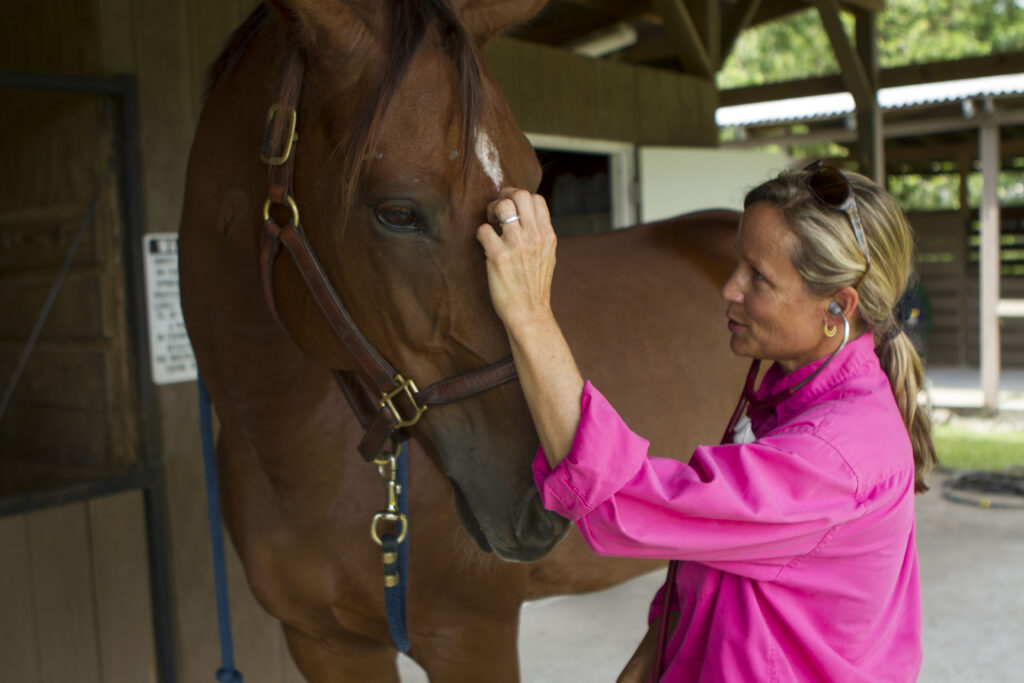
Periodic preventative care checkups, performed at least bi-annually, can be key to catching many age-related conditions and diseases that owners may not notice in their everyday care due to a gradual onset. Involving your veterinarian in the management of your senior horse will go a long way toward ensuring their health and happiness throughout their golden years. Reach out to your Palm Beach Equine Clinic veterinarian for any questions about your horse’s health at any age by calling 561-793-1599 to schedule an appointment.
Appointment Request
Please fill out this form and our staff will contact you to confirm an appointment.

From a veterinary perspective, horses can be considered “middle-aged” by 13 years of age, and “seniors” by 20 years of age. Although many sport horses may just be coming into their prime for training and competing during these years, horses show signs of aging at different rates just like humans do. As horses age some physiological functions start to decline, and they require extra care to maintain their overall health and condition.
Advances in diagnostics, therapies, and medications can help to support equine athletes and keep them performing well into their golden years. While many of the same health factors apply to horses of all ages, several additional and significant concerns should be considered for the aging horse.
Meet your horse’s nutritional needs

Aging impacts a horse’s ability to digest and utilize the nutrients in its feed as well as its ability to maintain weight and muscle mass. Senior horses require a diet that is highly digestible, palatable, and has an amino acid profile that will maintain muscle mass. As diet is one of the most crucial facets of a horse’s care, owners can consult their veterinarian to make sure they are fueling their aging horse with an adequate ratio and amount of high quality of forage, grains, vitamins, and minerals.
“When it comes to the best nutrition for senior horses, access to high-quality forage is very important and some horses may need free-choice quality hay to maintain optimum health,” said Dr. Marilyn Connor of Palm Beach Equine Clinic. “There are many commercially available feeds labeled as “senior” that are formulated to meet the dietary needs of the middle age to senior horse. These feed products are often beneficial to all adult horses as they are processed to be nutrient dense and highly digestible.”
There are many additional factors that go hand-in-hand with feeding a senior horse, such as minimizing the risks of colic and ensuring the best dental health. A veterinarian will be able to advise the owner if their senior’s diet is meeting the horse’s needs and setting them up for success in the years to come.
Be mindful of dental health
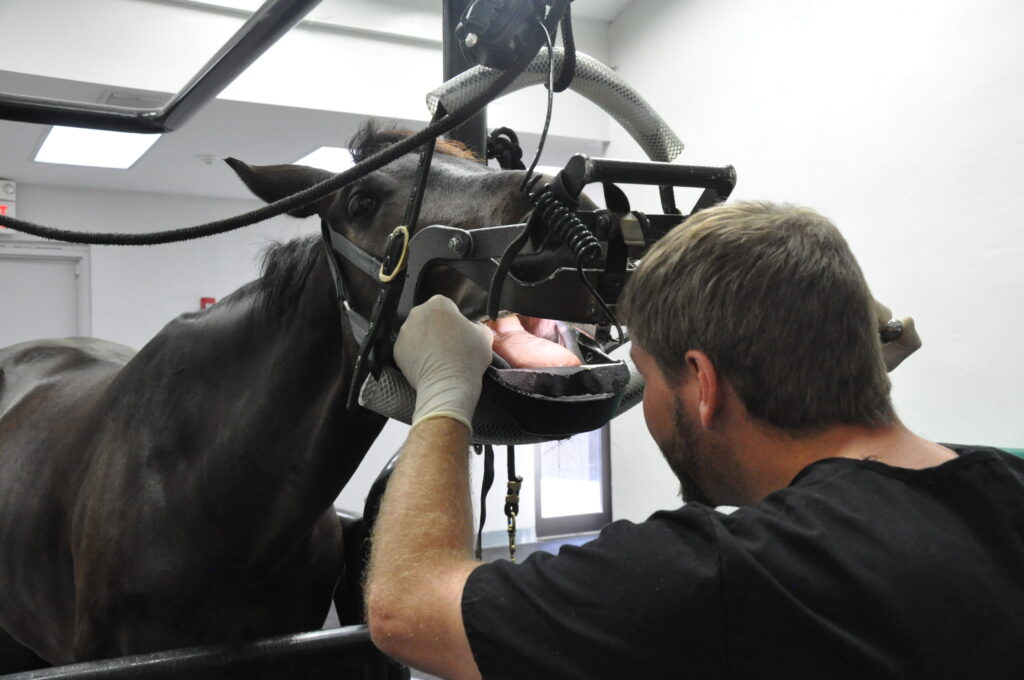
The digestion process begins in the mouth, so maintaining good dental health is imperative. Equine teeth, unlike human or a small animal teeth, will continue to grow throughout the horse’s life. An annual dental exam by a veterinarian will go far in preventing and fixing sharp points, hooks, chipped or fractured teeth, or damage to soft tissue within the mouth.
“In geriatric horses, the teeth are no longer erupting as quickly and as a result they may not develop sharp points as quickly. With age however, the teeth wear which causes the crown to thin and roots to shorten. As this happens, the teeth are more prone to damage and fracture. Regular dental exams – at least on an annual basis – will catch these potential issues sooner than if allowed to become problematic.”
Dr. Tyler Davis of Palm Beach Equine Clinic
“Another condition more common in geriatric horses is Equine Odontoclastic Tooth Resorption and Hypercementosis (EOTRH). This condition affects the incisors and occasionally the canine teeth and can be very painful. Often times, EOTRH can be recognized as irritability, head shyness, or if the horse struggles to bite treats like carrots. We can make a definitive diagnosis of this through taking radiographs,” continued Dr. Davis.
Monitor internal health

Older horses are more prone to developing endocrine diseases such as Equine Metabolic Syndrome (EMS) or Pituitary Pars Intermedia Dysfunction (PPID or Cushing’s disease). These diseases can lead to progressive deterioration of healthy tissue and have major negative effects on almost every bodily system in the horse. A horse with unmanaged PPID is more likely to experience episodes of laminitis, chronic infections, anhidrosis, and infertility, as well as career-ending soft tissue injuries. Research indicates that between 20 to 30 percent of horses over the age of 13 have PPID, many with no clinical signs making the disease go unnoticed.
“I recommend that all my patients over the age of 13 start annual endocrine metabolic testing to look for early changes associated with PPID or EMS. Horses can start to develop these diseases at as early as seven-years-old. I think it is critical to be proactive in the middle-age and senior horse so we can start treatments to correct the hormone imbalances before they begin to cause long term damage or the horse sustains an injury that might have otherwise been avoided.”
Dr. Marilyn Connor of Palm Beach Equine Clinic
Routine blood tests, such as a Complete Blood Count (CBC) or Serum Chemistry analysis are useful in identifying changes to the horse’s red and white blood cell counts (to see if they may be anemic) and to assess internal organ function. Having your horse tested every six to 12 months will be helpful for tracking and detecting any changes in their health and implementing treatment early on.
Immune system function also gradually declines with age, making middle-age and senior horses more susceptible to illnesses. It is important for owners to stay vigilant and up to date on their horse’s core vaccines, and to consult their veterinarian about timing and frequency of boosters to make sure their horse is protected.
Palm Beach Equine Clinic also recommends routine fecal testing to evaluate the horse’s internal parasite count and implementing a consistent deworming program. This is imperative for clients based in Florida year-round due to the lack of frost which usually kills many parasite eggs in northern climates. Fecal egg count testing should be performed twice per year, in the spring and fall, to assess parasite load in the intestines. It is important to note that not all parasites are susceptible to every deworming product, and the results of a fecal test will give the veterinarian insights as to the type of parasites and which dewormer is best to administer for that unique horse. Palm Beach Equine Clinic veterinarians have access to the laboratory equipment onsite to run the vast majority of these tests for rapid same day results.
Click here for Part 2 of Considerations for the Aging Performance Horse.
Get in Touch with Palm Beach Equine Clinic
Contact us by filling out this form.
Horse owners often joke that they take better care of their horses than they do themselves. While there are maintenance treatments and products that could be considered a luxury, veterinary chiropractic adjustments do not fall into that category. Palm Beach Equine Clinic veterinarian Dr. Ryan Lukens is a certified Veterinary Medical Manipulation Practitioner from the Chi Institute in Ocala, FL, and recommends every horse reap the benefits of regular chiropractic adjustments.
 “One of the most beneficial outcomes of regular veterinary chiropractic adjustments is an increase in range of motion,” said Dr. Lukens. “Ensuring the horse has proper range of motion can greatly reduce the chances of them having to physically compensate for an area that may not be functioning up to par. By reducing the chances of compensation, we reduce the chances of many common sport hose injuries. Most athletic injuries occur when a horse is slightly off balance due to compensating. Regular chiropractic adjustments help horses to maintain their natural balance.”
“One of the most beneficial outcomes of regular veterinary chiropractic adjustments is an increase in range of motion,” said Dr. Lukens. “Ensuring the horse has proper range of motion can greatly reduce the chances of them having to physically compensate for an area that may not be functioning up to par. By reducing the chances of compensation, we reduce the chances of many common sport hose injuries. Most athletic injuries occur when a horse is slightly off balance due to compensating. Regular chiropractic adjustments help horses to maintain their natural balance.”
According to Dr. Lukens, further benefits of veterinary chiropractic adjustments include:
- Relief of pain and soreness
- Reversal of muscle atrophy by increasing the frequency of nerve activation
- Increasing the speed and accuracy of athletic movement
- Adjustments help calm the “fight or flight” response. This has a domino effect of improving various bodily functions, such as neutralizing stomach acids, improving hind gut digestion, lowering blood pressure, lowering cortisol levels, and strengthening the immune system.
Dr. Lukens outlines the “must know” details of an equine chiropractic adjustment for any sport horse owner. Here’s what he would like you to understand about your horse’s chiropractic adjustment:
1. The major adjustment points.
I take a full body approach to every session. There are 205 bones that comprise the skeleton of a horse, however, I am not just adjusting the skeleton––I work to improve motion at segmented levels that involve bones and the supporting soft tissue structures and nerves. I was taught to use “motion palpation” to test moving segments. If a segment is not moving freely in the appropriate directional planes, I can perform an adjustment to correct the restriction of this movement.
Major adjustment points include the:
- Mandible and tongue
- Temporomandibular joint (TMJ)
- Poll and cervical vertebrae
- Withers and sternum
- Front and hind limbs
- Thoracic and lumbar vertebrae
- Pelvis/sacrum

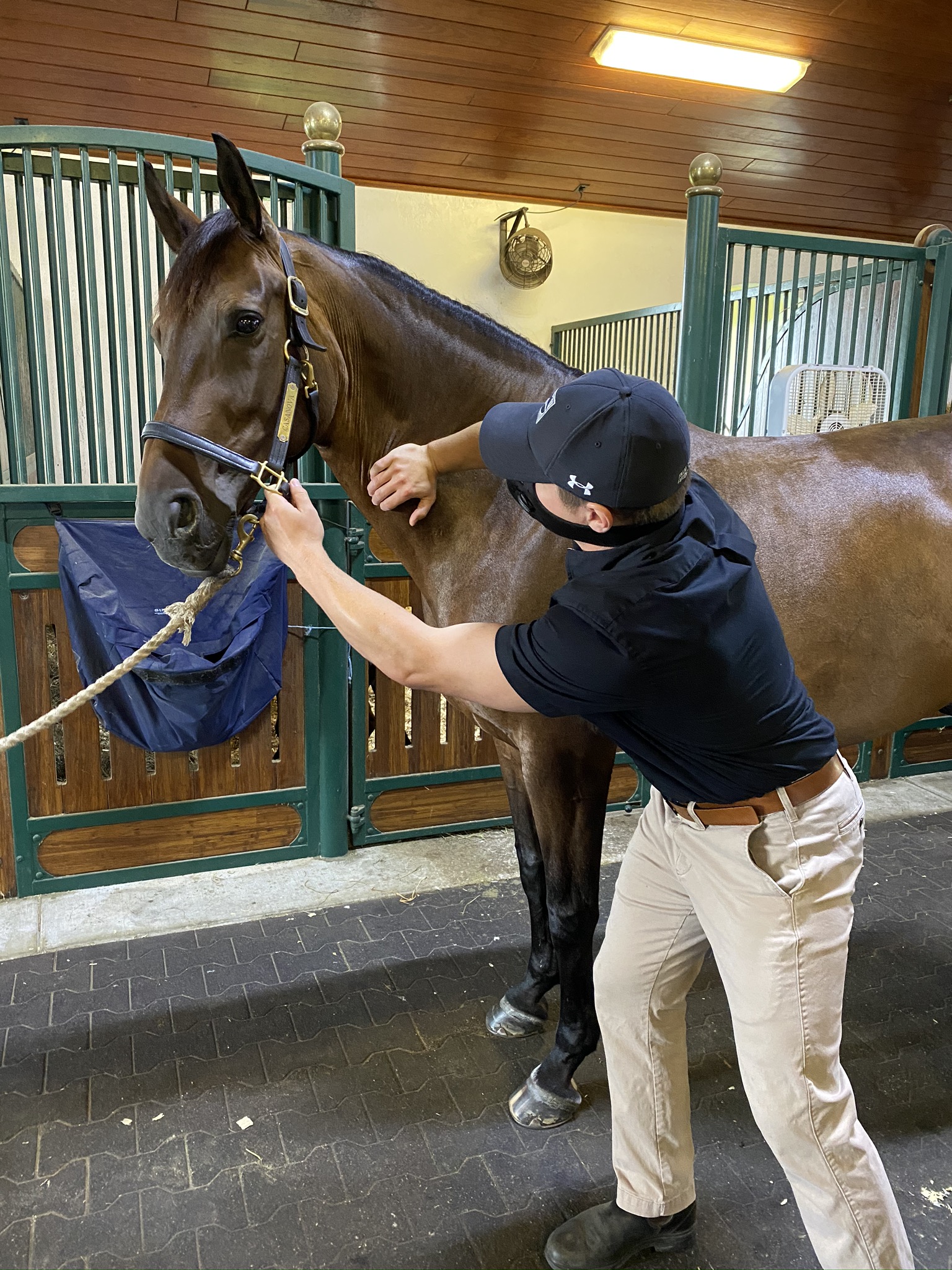
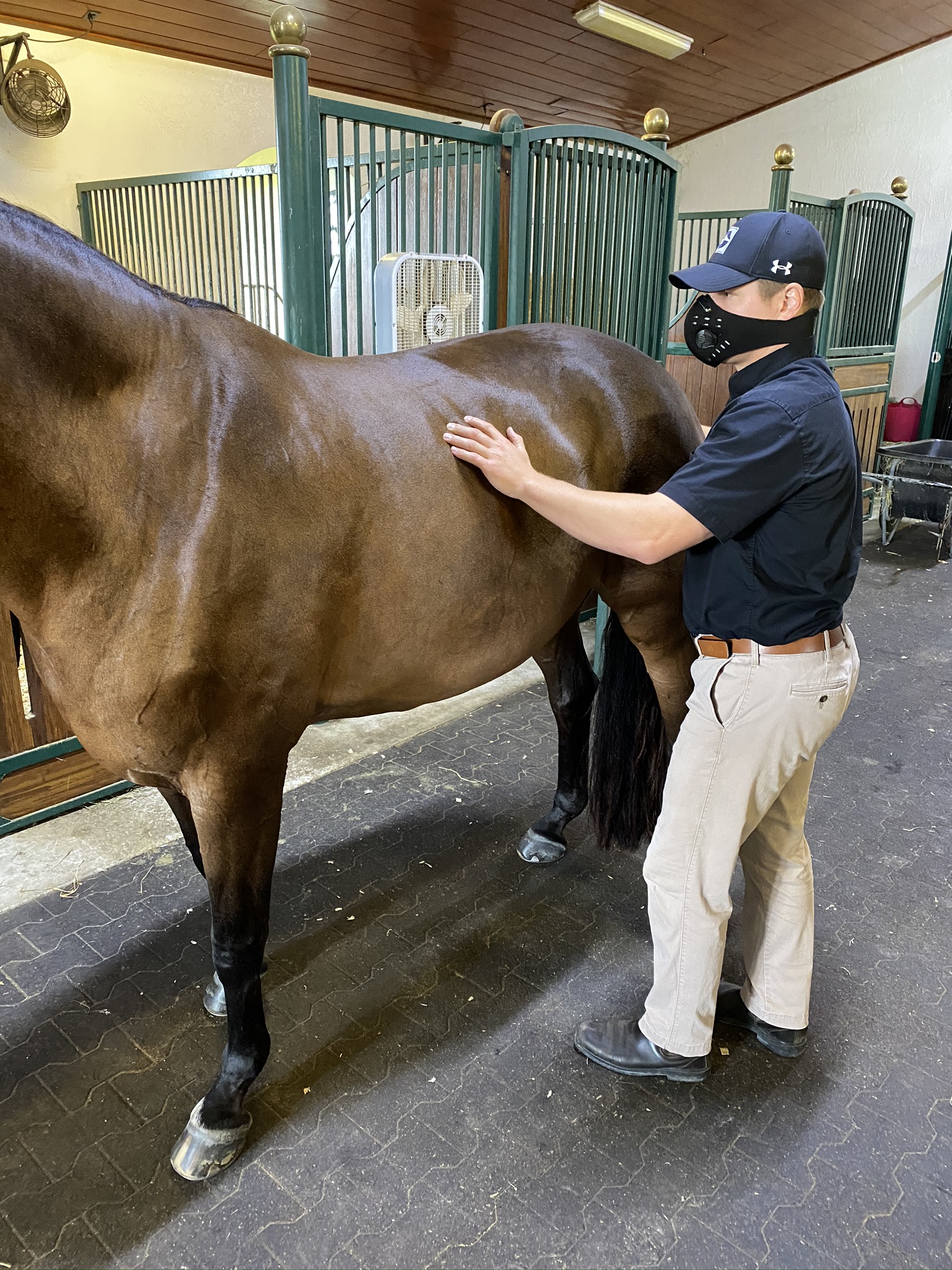

2. Every horse is different, and their discipline of riding places different demands on their bodies.
The most common adjustments for various performance horses include:
| Discipline | Common Adjustments |
|---|---|
| Dressage | Balance is essential for dressage. The major points of balance affected by veterinary chiropractic work are the TMJ, hyoid, sternum, and cervical facets. Other common adjustments affected by lateral work include the shoulders, elbows, and pelvis. |
| Hunter/Jumper | Hunters and jumpers typically benefit from vertebral adjustments of the lumbar and upper cervical regions, ribs, sternum, front distal limbs, and the shoulders. |
| Eventing | Most eventing horses benefit from adjustments to the pelvis, all cervical vertebrae, TMJ, ribs, and the shoulders. |
| Western Disciplines | Reiners benefit from adjustments to their right shoulder, lower cervical facets, withers and pelvis, and barrel racers benefit from shoulder, sacroiliac and hip joint adjustments. |
3. Things to keep in mind before and after an adjustment.
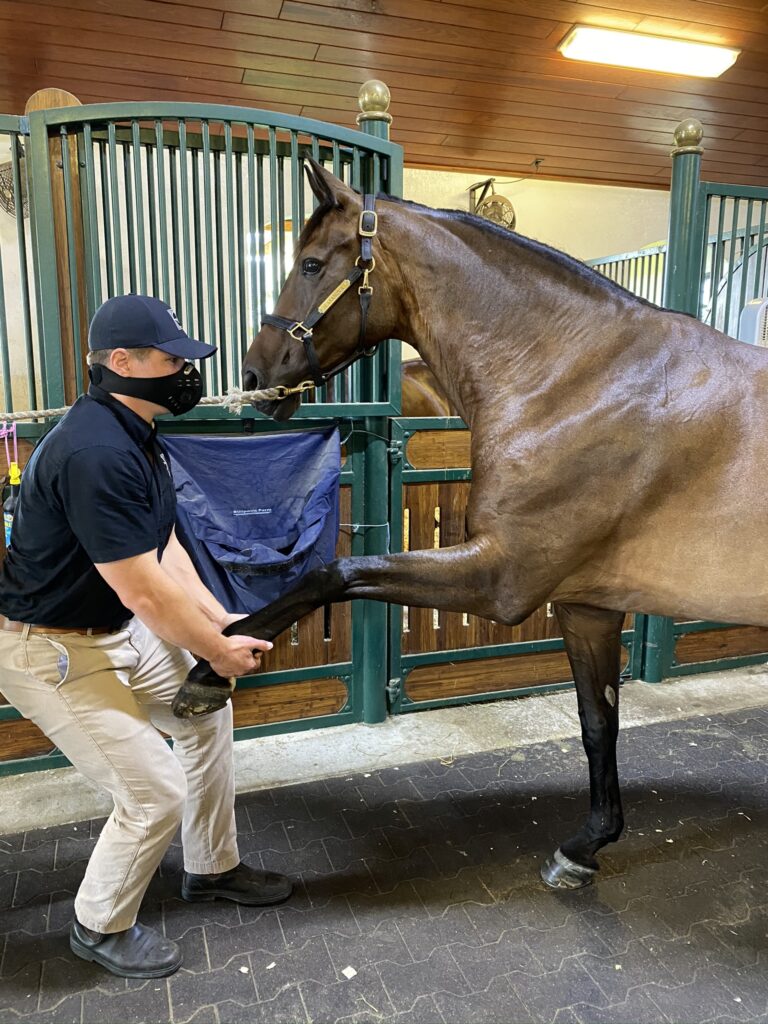
It is important that dental and farrier work is not overdue before veterinary chiropractic adjustments. Sharp dental points can cause adjustments to hold for shorter periods of time, especially in the poll, TMJ, and cervical vertebrae. In addition, if a horse is currently not shod well or has recently pulled a shoe, the adjustments of their limbs, back, pelvis and sacrum may not provide long lasting benefits.
Besides those prerequisites, a horse can be ridden before an appointment and have a normal day. The only restriction on riding is that they should not be ridden for the remainder of the day after the adjustment. However, they may be turned out to pasture after an adjustment. The following day, I encourage that the horse be ridden as normal and that the owner or rider follow up with me about how they felt.
I prefer to see new patients two weeks after their initial adjustment appointment. After the second appointment, I sit down with the rider to discuss and compare the chiropractic adjustments performed between the two sessions. If I made multiple of the same adjustments, their appointment intervals will stay at every two weeks. Once there is a decrease in similar adjustments, I can increase the time interval between sessions to three weeks. Some horses can maintain the adjustments for about four to six weeks when under lighter work. The rider can usually feel when a horse is due for another adjustment. As a rule, high-level performance horse can benefit from chiropractic adjustments as often as every week, but the most common interval for my clients at that level is every other week.
4. Chiro to the rescue! Common issues:
I often see some common issues solved by a veterinary chiropractic adjustment. For jumpers, changes in jumping style (i.e. landing away from a front limb, only jumping off of a certain lead) and performance (hitting more rails than normal) could indicate a lack of range of motion, which can be corrected through a proper adjustment or series of adjustments.
For dressage horses, a change in their balance could result in head tilting, not working through their back, lifting the lower cervical curve, or their hind limbs not following the path of the front limbs, and commonly seen in a new inability to perform tempi changes. That balance can be reestablished with an adjustment.

For western horses, a decrease in acceleration and turning can be indicative of needing adjustments.
5. How to choose your equine chiropractor.
The Chi Institute in Ocala, FL, trains only licensed veterinarians in medical manipulations (chiropractic adjustments). I believe that a veterinarian trained in chiropractic adjustments is the safest choice for the horse. A veterinarian’s extensive knowledge of anatomy and understanding of when not to adjust a horse is an important part of ensuring the horse’s safety and well-being. If done improperly, adjustments can have adverse effects. I received my certification (CVMMP, or Certified Veterinary Medical Manipulation Practitioner) in 2017 and have had great success in implementing chiropractic adjustments into my patients’ athletic successes.
To learn more about veterinary chiropractic adjustments or to schedule an evaluation for your horse, contact Dr. Lukens at Palm Beach Equine Clinic by calling 561-793-1599.
From The Pharmacy: New Xiang Ru San
Option for Anhidrosis

Palm Beach Equine Clinic is proud to offer a wide range of treatments and therapies, including select Chinese herbal medicines. New Xiang Ru San is one such herbal medicine that can be used to treat horses suffering from anhidrosis, or the inability to sweat normally. Anhidrosis can be a common challenge, particularly in hot, humid climates. New Xiang Ru powder has proven to be a clinically effective aid for non-sweaters as it promotes heat and fluid disbursement through healthy sweating. New Xiang Ru San is a blend of the Chinese herbs Bian Dou (hyacinth bean), Xiang Ru (mosla), Hou Po (magnolia bark), Lian Qiao (forsythia) and Jin Yin Hua (honeysuckle flower).
Chinese herbal medicine is a relatively new treatment among equine veterinarians in the western world, but the philosophy of using herbals in healing has existed for thousands of years as part of Traditional Chinese Veterinary Medicine (TCVM). An adaptation of all-natural methods used to treat humans, herbal medicine for animals utilizes ancient Chinese formulas aimed at understanding and treating the underlying causes of a particular disease or illness in order to help the body heal itself, rather than only treating the presented symptoms.
Talk to your PBEC veterinarian about options for treating anhidrosis or call 561-793-1599 to set up an appointment.
Appointment Request
Please fill out this form and our staff will contact you to confirm an appointment.
A Healthy Mouth is a Supple Mouth
Healthcare Reminder: Equine Dentistry
The general goals of equine dentistry may appear straight-forward but include a complex system of evaluations that in turn affect the entire body and well-being of a horse. At its core, equine dentistry encompasses the objectives of maintaining even tooth wear, treating infection or disease, allowing for proper digestion, and promoting longevity. Dr. Tyler Davis of Palm Beach Equine Clinic says that routine and thorough dental exams can help prevent many issues from ever becoming problems.
Why do horses require dental care?
Horses grind their food into a finely masticated bolus before swallowing. The combination of a horse’s upper jaw being larger than the lower jaw, and the fact that a horse chews by moving their jaws from side to side results in uneven wear of the teeth. This uneven wear may cause sharp edges to form, which hinder efficient chewing and may ulcerate or tear the cheeks and tongue. Uneven wear can also cause the horse to swallow food that isn’t properly chewed and can lead to more daunting problems such as colic.
No horse is exempt from needing their teeth cared for by a veterinarian. For sport horses, however, dental care becomes even more crucial. Much of the connection between horse and rider comes by way of the horse’s mouth, and depending on the discipline, the horse may always have pressure in their mouth. If there are problems or discomfort within the mouth, it can become evident in the horse’s performance and disposition under saddle.
According to Dr. Davis, having a horse’s teeth in perfect shape allows one to immediately rule out dental issues when trying to troubleshoot a performance problem. A “sound mouth” also allows the best condition for supple, soft, and accurate connections between horse and rider through the bridle.
What is floating?
On a basic level, most horses require a routine float. Floating is the term for rasping or filing a horse’s teeth to ensure an even, properly aligned bite plane. While floating is the physical process, the scope of equine dentistry is much broader and examines the horse’s overall health as influenced by the mouth.
“A proper dental exam using a lightweight speculum, a very good light source, and a dental mirror allows me to see any possible problems and prevent those problems from becoming painful and affecting a horse’s performance and overall health,” said Dr. Davis.
How often should you have a veterinarian perform a routine dental exam on your horse?
Dr. Davis recommends an exam every 12 months at a minimum. For many sport horses, the demands of their competition schedule may require bi-yearly exams to prevent any problems that could sideline them from training or events. Lastly, any horse with a history of dental problems may require exams every three to four months. Without routine dental exams by a veterinarian, uneven wear can escalate to a serious health problem.
The most common signs of dental discomfort in horses include:
- head-tilting and tossing
- difficulty chewing
- bit-chewing and tongue lolling
- tail-wringing, bucking and other behavioral issues
- drooling and bad breath
- (sometimes) weight loss and spillage of grain
Technological Advances
While it is the owner’s responsibility to develop a diligent care routine, the veterinary community has done its part by continuously improving evaluation and diagnostic technology. Advances in instruments, such as the speculum and imaging technologies, allow veterinarians to better understand and examine the equine mouth. In turn, they are able to diagnose and treat dental problems more effectively.
Equine dental health is far more involved than simply evaluation the outward appearance of the teeth. While trained eyes can see external problems, and educated hands can feel for abnormalities, assessing internal issues can be done through diagnostic imaging. Improved imaging technology has greatly expanded Dr. Davis’ ability to find and analyze unseen problems in the mouth.

Portable imaging technology, such as digital radiography (x-rays) allows him to conveniently understand dental pathology better for his patients in the field. While Standing Computed Tomography (CT) allows Dr. Davis to capture a comprehensive, multiplanar profile of all the structures within the horse’s head, with the horse only lightly sedated.
“Having these advanced imaging modalities available for my patients allows us to thoroughly identify an issue and then intervene as early as possible to treat the issue, relieve discomfort, or prevent tooth loss,” commented Dr. Davis.
Contact your veterinarian at Palm Beach Equine Clinic for more information on equine dentistry, or to schedule a dental exam, at 561-793-1599.
Get in Touch with Palm Beach Equine Clinic
Contact us by filling out this form.
A Look at Palm Beach Equine Clinic’s Advanced Imaging Technology
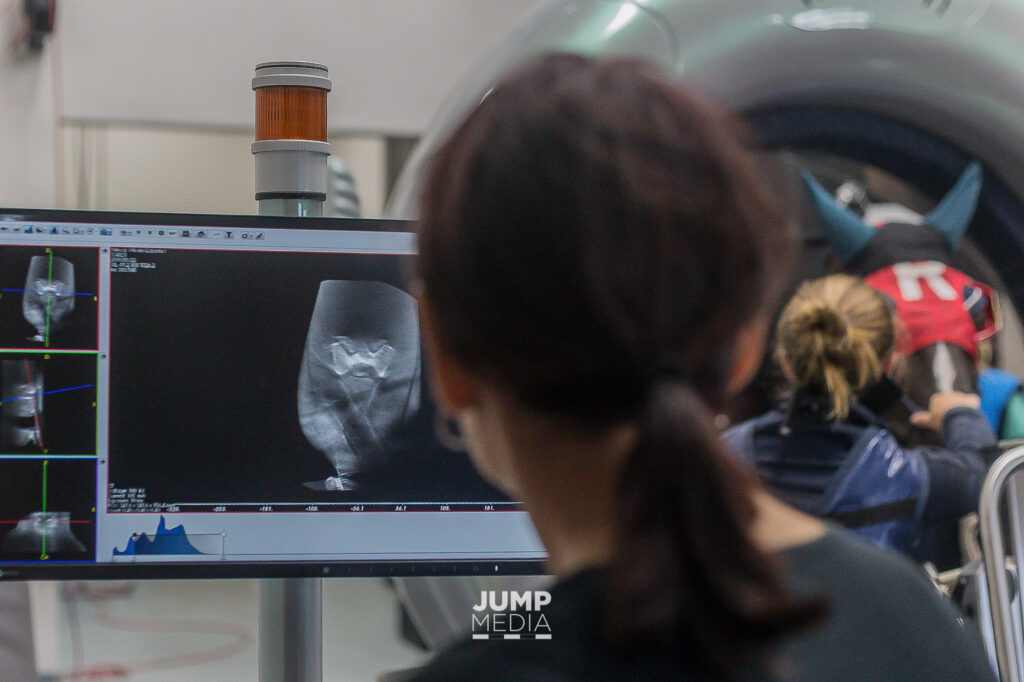
Photo by Jump Media
Palm Beach Equine Clinic takes pride in being a world-class facility for the diagnosis, treatment, and recovery of some of the industry’s most valued sport horses, as well as backyard companions. A vital area of the Equine Hospital that helps veterinarians to diagnose subtle or acute lameness is the Advanced Imaging Department.
Producing thousands of scans a year across all modalities, the Palm Beach Equine Clinic Imaging Department offers an on-staff, board-certified radiologist, and equipment that elevates the effectiveness of lameness diagnostics. Lameness is no longer a guessing game as PBEC veterinarians have an arsenal of imaging technologies to capture inside the horse.
Tour the PBEC Imaging Department:

Nuclear Scintigraphy (Bone Scan)
Nuclear scintigraphy begins with the injection of a radioactive isotope called Technetium 99 that is bound to a phosphate analogue. The isotope – phosphate molecule attaches to the mineral matrix of the bone in areas where bone is active. A gamma camera is then used to capture images of the skeletal anatomy. Points that “light up” on the image indicate increased metabolic activity as a possible site of injury.

Standing Magnetic Resonance Imaging (MRI)
The standing MRI produces highly detailed, cross-sectional images of bone and soft tissue in multiple different planes to fully image a desired region. The standing MRI requires sedation (not anesthesia) and is best used to further define a specific area that has already been pinpointed as the origin of lameness.
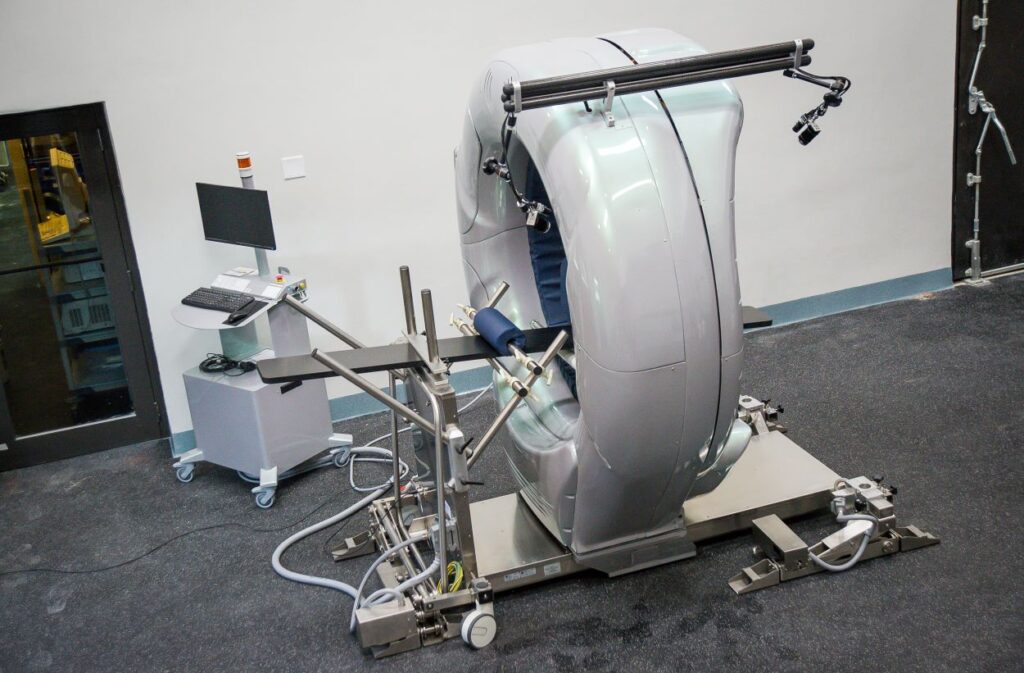
Computed Tomography (CT)
Similar to its use in humans, CT allows veterinarians the unique opportunity to conveniently explore areas of a horse’s body that were previously inaccessible. The machine produces 360 degree images of a horse’s neck, spine, and head and can be conducted while a horse is standing and under only light sedation.
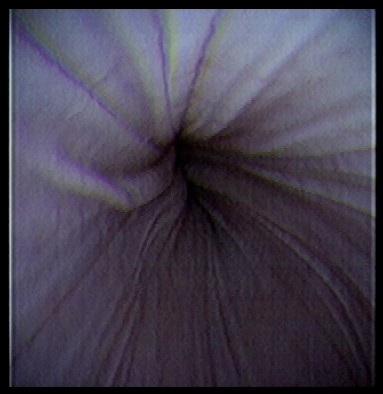
Endoscopy
An endoscope is an instrument that allows veterinarians to look inside the body by being inserted through a natural opening or incision. A tiny camera on the instrument allows an in-depth view of internal structures such as the upper and lower respiratory track, gastrointestinal and urinary tracts, as well as the cervix and uterus of mares.

Digital Radiography
Used routinely, radiographs are traditional x-rays that are made available within seconds for digital viewing and evaluation.
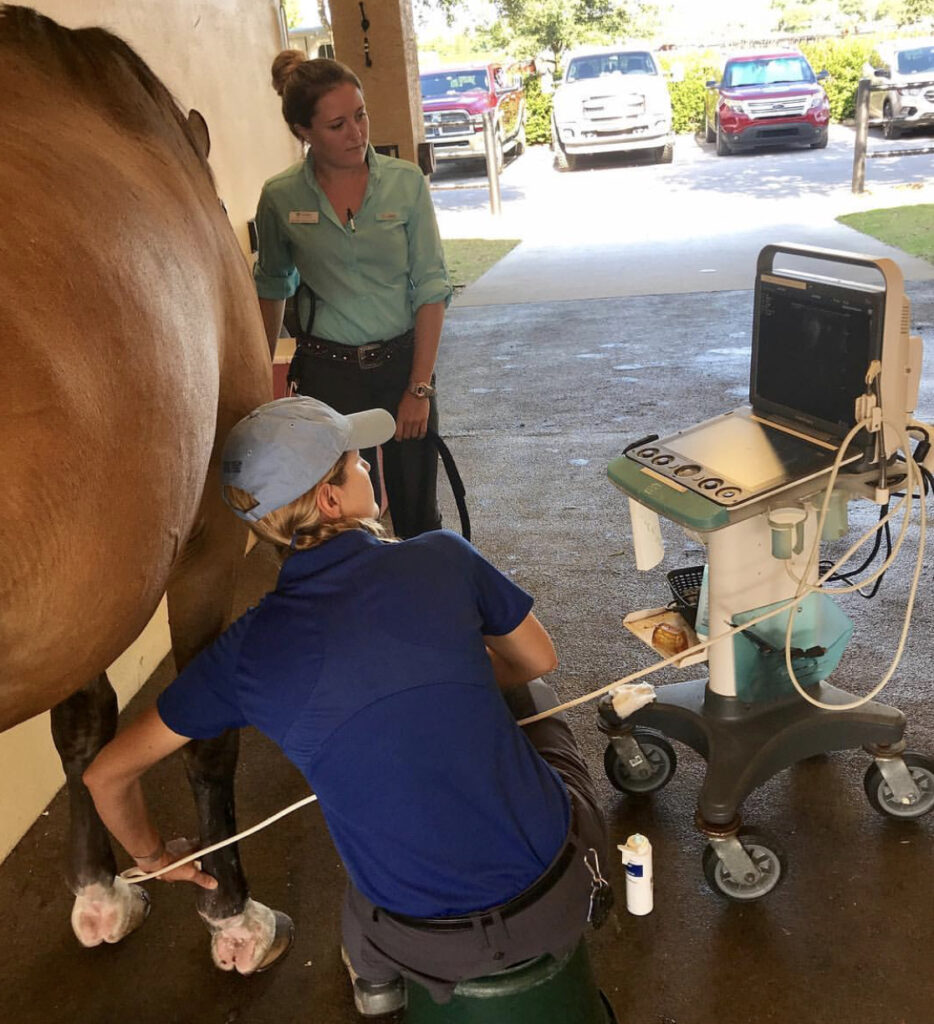
Ultrasonography
An ultrasound machine generates high-frequency sound waves, which echo an image back to the machine where bone appears white, fluid appears black, and all other structures are on a grayscale. An ultrasound is non-invasive, usually does not require sedation, does not use radiation or require injecting radioactive isotopes, and provides real-time images.
“These tools can give a definitive diagnosis, and that saves time and money in the long run,” said board-certified radiologist Dr. Sarah Puchalski. “For example, if a horse goes lame and it gets seen and treated empirically, which is a diagnosis based on likely problems through common diagnostic procedures, it either stays sound or it becomes lame again or even non-functional in three to six months. This method sets back the commencement of the appropriate therapy.
“What these modalities do is allow the horse to be treated early and correctly,” continued Dr. Puchalski. “Otherwise, you may not be treating the correct issue, and the horse could end up lame again very soon.”
Brittany Riddle, manager of PBEC’s Nuclear Scintigraphy Department, is fascinated by the structure of the horse’s body and helps to produce hundreds of bone scans per year.
“I’ve always had a strong interest in the anatomy of horses,” said Riddle, who spends her workday keeping patients comfortable and calm while operating a gamma ray camera housed in its own suite at Palm Beach Equine Clinic. “The horses are under light sedation for standing scans and these usually take from one to four hours depending on the type of scan. Usually during the winter competition season, we have anywhere from two to three horses being scanned daily.
“The variety of patients we treat is always interesting,” continued Riddle. “We see patients from all aspects of the industry. From racehorses to polo ponies, western performance, dressage, top show jumpers and hunters.”
According to Palm Beach Equine Clinic President Dr. Scott Swerdlin, having the latest in diagnostic capabilities drives the success of the Clinic.
“Many years ago, we committed to establishing Palm Beach Equine Clinic as an all-inclusive hospital and making it the most advanced referral center in the country,” said Dr. Swerdlin. “By investing in the very best personnel and equipment, we are able to provide the very best care we can for our patients.”
Palm Beach Equine Clinic is the only equine veterinarian based in Wellington, FL, with the powerful SmartRLT Laser.
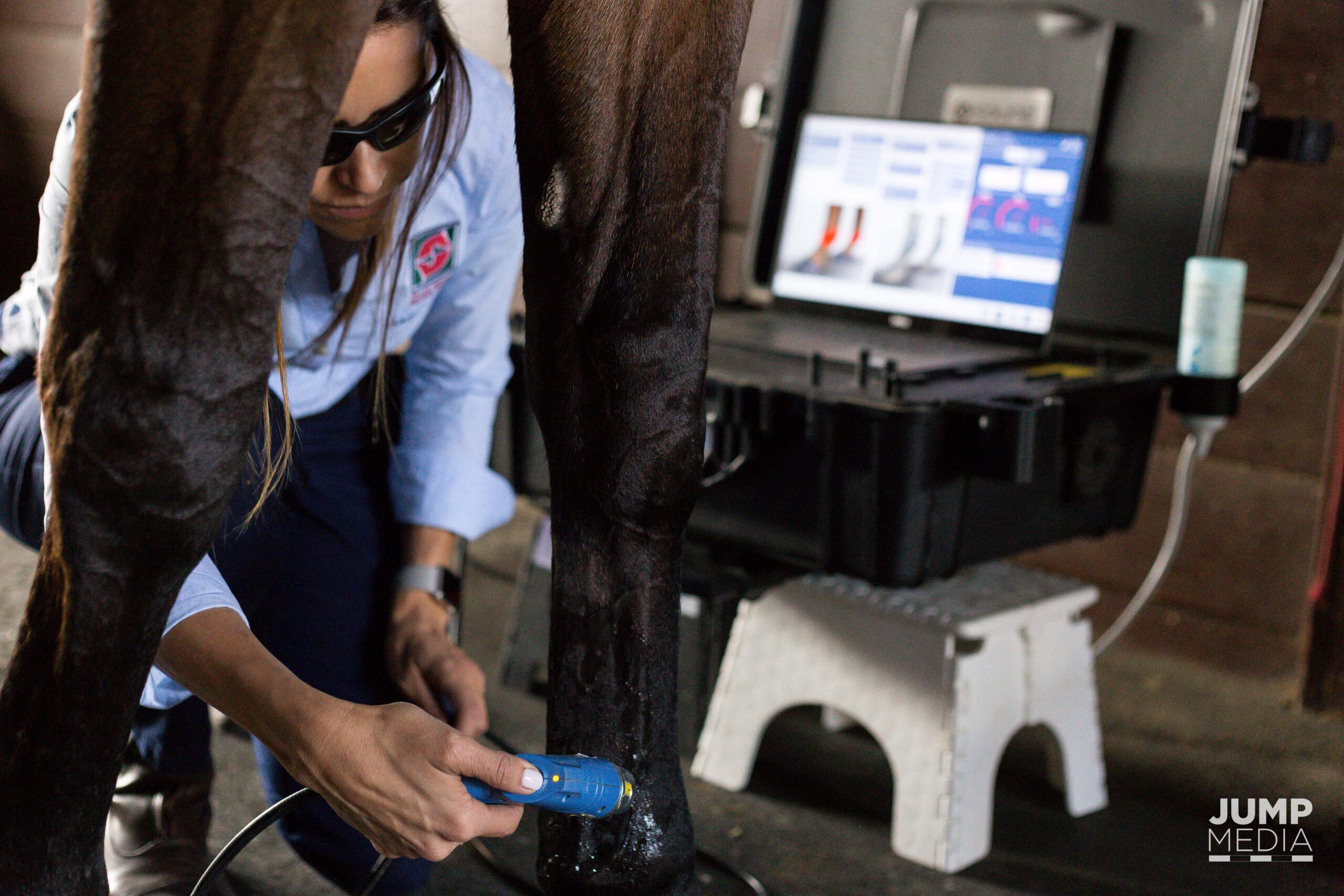
Dr. Natalia Novoa utilizes this revolutionary sport horse medicine tool to treat a variety of injuries and wounds with clinically documented success. The SmartRLT laser is a portable Class IV laser, the most potent and dynamic on the market, as an essential non-invasive therapy for use in the barn and at horseshows. Not only is Dr. Novoa’s regenerative laser extremely effective in treating injuries that were previously considered career-ending, but it is also especially beneficial for enhancing body condition and performance of the equine athlete.
Clinical and scientific results of the SmartRLT include:
- Repair of ligament and tendon lesions
- Reduces scar tissue within and around injuries
- Reduces inflammation
- Increases collagen production
- Increases blood circulation to bring nutrients to the site
- Realigns muscle fibers for stronger healing
- Provides analgesia (reduces pain)
- Enhances tissue oxygenation
- Increases cell proliferation (generates more cellular energy)
Regenerative Laser Therapy has successfully treated injuries to structures such as:
- Cartilage/bone/joints
- Neck and poll, stifles, temporo mandibular joint (TMJ), hocks, fetlocks, and coffin joint
- Sore feet and laminitis
- Sore muscles (especially back and gluteal)
- Suspensory ligaments and branches
- Superficial flexor tendons
- Deep digital flexor tendon and its insertion inside the hoof
- Inferior and superior check ligaments
- Collateral ligaments
- Summer sores and scratches
- Scar tissue
- Open wounds and punctures
- Sub-dermal infections
- Post-operative incisions
- Sacroiliac joint and kissing spine
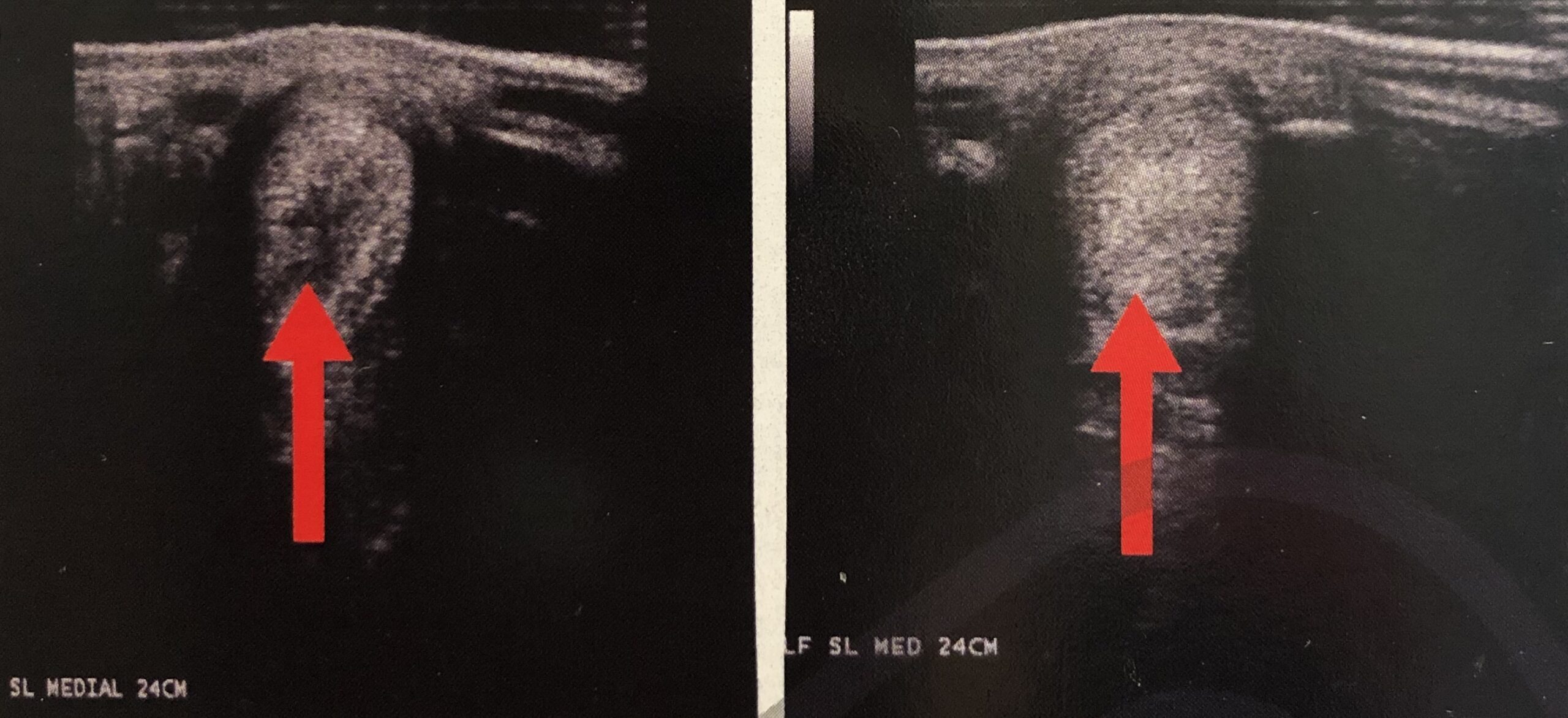

Regenerative Laser Therapy Case Study: Lameness
| Patient Condition | Grand Prix level show jumper with left front lameness. |
| Evaluation | Magnetic Resonance Imaging (MRI) showed intra-osseous fluid accumulation in the left front third metacarpal condyle. |
| Treatment | 20 sessions of Dr. Novoa’s SmartRLT. |
| Result | Fluid in the third metacarpal condyle was resolved. |

Custom Treatment for Your Unique Horse

Dr. Novoa’s SmartRLT is a pioneering technology that has evidence-based settings and treatment protocols to optimize the effectiveness for each unique patient. Treatments are customized for the specific structure, acute or chronic conditions, deep to superficial and skin pigmentation to reach the best outcomes.
Regenerative Laser Therapy provides a warm, soothing sensation and does not require sedation. Treatments can be performed at the barn or horseshow. Be sure to share your competition schedule with your veterinarian so treatments can be done within a safe and legal timeframe.
General Protocols for Regenerative Laser Treatments
Pre and Post Performance: 1-3 sessions
Acute Conditions: 6-10 sessions for the first two weeks
Chronic Conditions: 2-3 sessions per week for approximately 10 weeks
Laser Therapy 101
Laser therapy is beams of electromagnetic energy that interact chemically and biologically with the targeted tissue or injury. This creates photobiomodulation, allowing maximum penetration of tissue structures. Laser therapy releases endorphins while increasing cellular activity, blood flow and enhancing tissue oxygenation. Essentially, it enhances the body’s natural healing mechanisms and expedites the restorative process.

Regenerative Laser Therapy goes far beyond standard lasers.
Regenerative Laser Therapy releases greater energy per pulse to create a photomechanical effect at the cellular level. It can be directed to the target injury or lesion to regenerate, revitalize, remodel, repair and realign tissue. Therefore, it is essential for equine sports medicine, lameness, rehabilitation and optimizing performance.
Regenerative Laser Therapy may only be administered by a veterinarian. Dr. Novoa is the only veterinarian based full-time in South Florida offering the SmartRLT treatments.

